
Fucus vesiculosus, known by the common names bladderwrack, black tang, rockweed, sea grapes, bladder fucus, sea oak, cut weed, dyers fucus, red fucus and rock wrack, is a seaweed found on the coasts of the North Sea, the western Baltic Sea and the Atlantic and Pacific Oceans. It was the original source of iodine, discovered in 1811, and was used extensively to treat goitre, a swelling of the thyroid gland related to iodine deficiency.
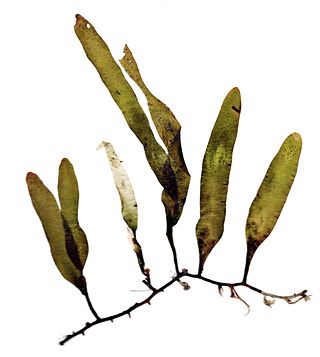
Caulerpa is a genus of seaweeds in the family Caulerpaceae. They are unusual because they consist of only one cell with many nuclei, making them among the biggest single cells in the world.

Halimeda is a genus of green macroalgae. The algal body (thallus) is composed of calcified green segments. Calcium carbonate is deposited in its tissues, making it inedible to most herbivores. However one species, Halimeda tuna, was described as pleasant to eat with oil, vinegar, and salt.

Porphyra is a genus of coldwater seaweeds that grow in cold, shallow seawater. More specifically, it belongs to red algae phylum of laver species, comprising approximately 70 species. It grows in the intertidal zone, typically between the upper intertidal zone and the splash zone in cold waters of temperate oceans. In East Asia, it is used to produce the sea vegetable products nori and gim. There are considered to be 60–70 species of Porphyra worldwide and seven around Britain and Ireland, where it has been traditionally used to produce edible sea vegetables on the Irish Sea coast. The species Porphyra purpurea has one of the largest plastid genomes known, with 251 genes.
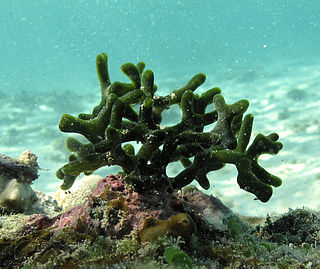
Codium is a genus of edible green macroalgae under the order Bryopsidales. The genus name is derived from a Greek word that pertains to the soft texture of its thallus. One of the foremost experts on Codium taxonomy was Paul Claude Silva at the University of California, Berkeley. P.C. Silva was able to describe 36 species for the genus and in honor of his work on Codium, the species C. silvae was named after the late professor.
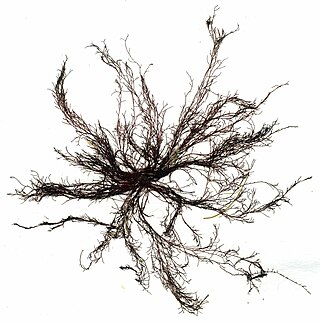
Polysiphonia is a genus of filamentous red algae with about 19 species on the coasts of the British Isles and about 200 species worldwide, including Crete in Greece, Antarctica and Greenland. Its members are known by a number of common names. It is in the order Ceramiales and family Rhodomelaceae.

Udotea is a genus of green algae in the family Udoteaceae.
Drachiella is a genus of marine red alga. It has scaly thickenings; also "rhizoids fringing openings". It is found below the kelp zone in areas exposed to moderate wave action; it is iridescent, and consists of a short, narrow stipe broadening into midribless thalli which reach 7 cm in length. Drachiella exhibits diffuse intercalary and marginal growth, and rhizoids are common along the margins, which it uses for anchorage. Pit connections often link adjoining cells.

Asparagopsis armata is a species of marine red algae, in the family Bonnemaisoniaceae. English name(s) include red harpoon weed. They are multicellular eukaryotic organisms. This species was first described in 1855 by Harvey, an Irish botanist who found the algae on the Western Australian coast. A. armata usually develops on infralittoral rocky bottoms around the seawater surface to around 40m of depth. Marine algae like A. armata are considered "autogenic ecosystem engineers" as they are at the very bottom of the food chain and control resource availability to other organisms in the ecosystem.

Halimeda tuna is a species of calcareous green seaweed in the order Bryopsidales. It is found on reefs in the Atlantic Ocean, the Indo-Pacific region and the Mediterranean Sea. Halimeda tuna is the type species of the genus Halimeda and the type locality is the Mediterranean Sea. The specific name "tuna" comes from the Taíno language, meaning "cactus" and referring to the resemblance of the thallus to the growth form of an Opuntia cactus.

Ulva intestinalis is a green alga in the family Ulvaceae, known by the common names sea lettuce, green bait weed, gutweed, and grass kelp. Until they were reclassified by genetic work completed in the early 2000s, the tubular members of the sea lettuce genus Ulva were placed in the genus Enteromorpha.
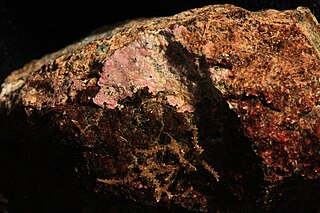
Hildenbrandia is a genus of thalloid red alga comprising about 26 species. The slow-growing, non-mineralized thalli take a crustose form. Hildenbrandia reproduces by means of conceptacles and produces tetraspores.

Acetabularia acetabulum is a species of green alga in the family Polyphysaceae. It is found in the Mediterranean Sea at a depth of one to two metres.

Dictyota is a genus of brown seaweed in the family Dictyotaceae. Species are predominantly found in tropical and subtropical seas, and are known to contain numerous chemicals (diterpenes) which have potential medicinal value. As at the end of 2017, some 237 different diterpenes had been identified from across the genus.
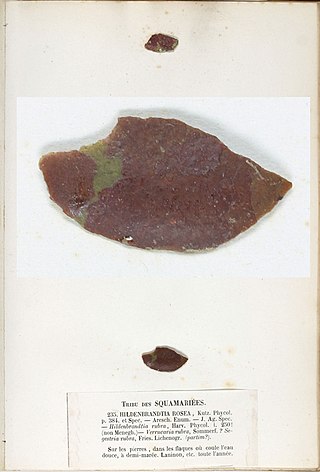
Hildenbrandia rubra is a marine species of thalloid red alga. It forms thin reddish crusts on rocks and pebbles in the intertidal zone and the shallow subtidal zone. It is a common species with a cosmopolitan distribution, and is able to tolerate a wide range of conditions.
Dictyota implexa is a species of brown alga found in the temperate eastern Atlantic Ocean and the Mediterranean Sea.

Dictyota dichotoma is a species of Brown algae found in the temperate western and eastern Atlantic Ocean, the Mediterranean Sea, the Black Sea, the Red Sea and the western Indian Ocean.

Halimeda opuntia, sometimes known as the watercress alga, is a species of calcareous green seaweed in the order Bryopsidales. It is native to reefs in the Indo-Pacific region, the Atlantic Ocean and the Mediterranean Sea.

Peyssonneliales is a monotypic order of red algae belonging to the class Florideophyceae and the subclass Rhodymeniophycidae. It contains only 1 known family, PeyssonneliaceaeDenizot, M., 1968.

Hildenbrandia rivularis is a species of freshwater red algae. It forms red, crusty thalli on stones submerged in water, typically in streams and rivers, less commonly in lakes and brackish parts of seas. It occurs in scattered locations on almost all continents. The species was formerly considered an indicator of clean or slightly polluted waters. The scientific genus name is sometimes spelled in various orthographic variants, especially as Hildenbrandtia. The life cycle of this species was described by the Polish hydrobiologist Karol Starmach.
















